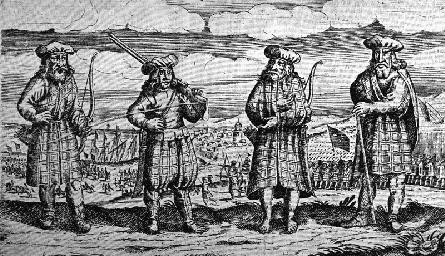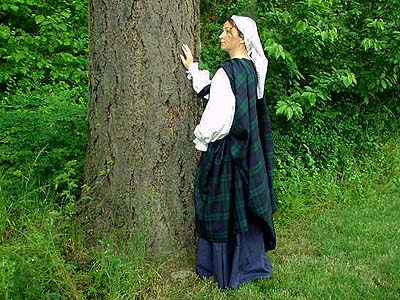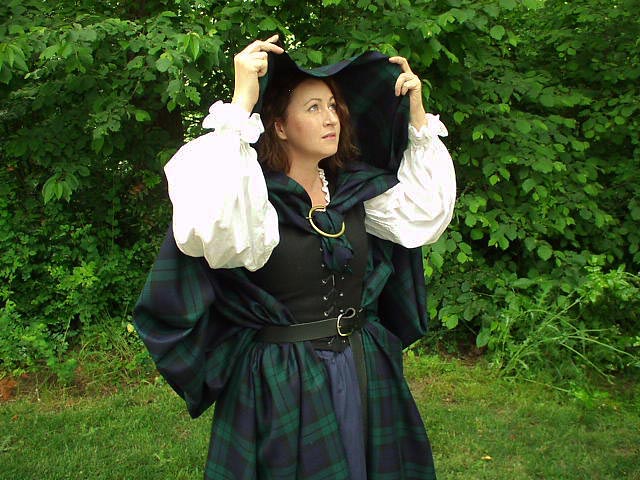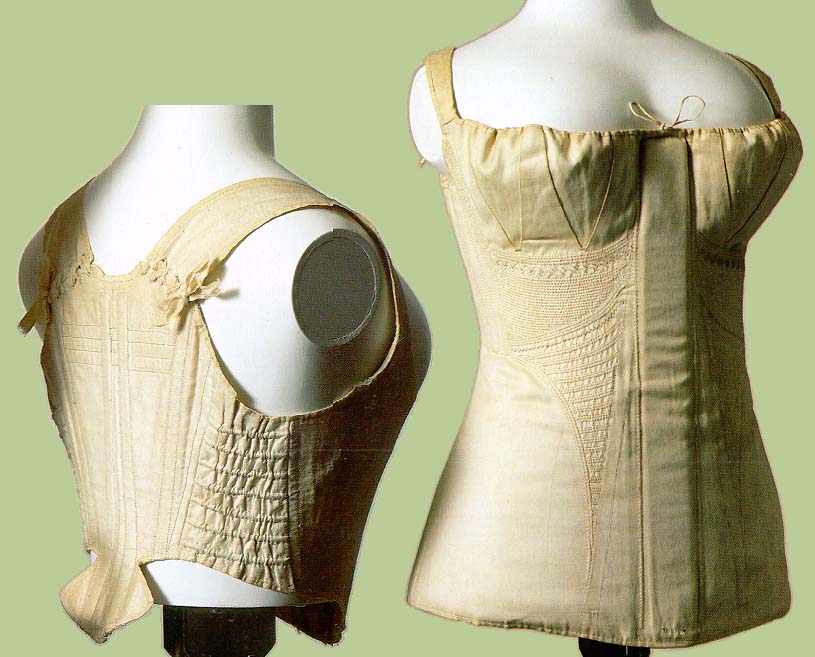
Although the Meigle Wightons were lowlanders, I'm going to start this description of Scottish clothing with some information about highlander dress. I found it interesting when I read it and I had some misconceptions - perhaps you do too. Also, there were some elements of the highlanders' dress that were common with lowlanders.
The basic element of dress of the Scottish highlander was a tunic or shirt, the plaid, trews (trousers), a jacket and shoes. The plaid here means a blanket or cloak; the word does not refer to the pattern of the material. The correct term for the pattern of the material would be tartan. The plaid was about 12 to 18 feet long by about 5 feet wide and was made of two strips of cloth each about 30 inches wide and sewn together. The plaid would be wrapped around one's body, the material being pleated or, more accurately, loosely gathered and secured at the waist by means of a belt. Typically, a portion of the belted plaid hung down to about the knees with the rest of the material being wrapped up around one's upper body in a variety of ways. (See picture above.) The belted plaid was the precursor to the kilt. An unbelted plaid could be worn with trews. In this case, the plaid would be worn over one shoulder and under the opposite arm.
The belted plaid had many advantages in the Highland climate and terrain. It allowed freedom of movement; it was warm - the upper half could provide a voluminous cloak against the weather. Also, it dried out quickly and with much less discomfort than trousers. If required, it could provide a very adequate overnight blanket simply by undoing the belt. Finally, the tightly woven wool proved almost completely waterproof.
The concept that everyone in the clan wore the same plaid pattern (or tartan) so that they would be recognized as belonging to the X clan is false. People generally wore a pattern of tartan common to the district that they lived in - but that was because weavers had their favorite patterns. Pictures of Scottish highlanders frequently show that their clothing was not all made up of the same tartan. Various pieces of clothing were woven with different tartans. (The concept of a tartan for each specific clan came into being in the 18th century after permission was given for Scots to once again wear the tartan. (Clans were forbidden to carry arms or wear tartan after the 1745 rebellion.)

Highland women probably wore what most country women wore in Scotland and England: a thin, shirt-like basic undergarment called a shift, several petticoats (skirts), the arisaid (the woman's form of the plaid), stays, a jacket, and a linen headcloth called a kertch (above). The kertch was a piece of white cotton muslin or fine linen cut into a perfect 3 ft. x 3 ft. square. It was folded into a triangle and the loose ends were tied together on top of the head so that the hair was inside. The kertch was fastened to the hair with cords or pins. Married women began wearing the kertch the day after their wedding - it was a symbol of their married status. Unmarried highland girls went without a head covering.

Women's Plaids or Arisaids could be a little different from men's plaids. They were about the same size, but sometimes were plain white or striped rather than tartan. Women wore the plaid like a shawl, with large silver brooches fastening them at the breast. At some point, women also started belting their plaids around themselves, very much as men did, pinning both upper ends of the plaid on their breast. The arisaid could be worn belted around the waist and the extra fabric could be worn as a hood to keep warm in the rain and cold. The excess could also be rolled and tied around the waist or tucked into the belt in warmer weather and to keep it from interfering with chores. It also provided lots of "pockets."

Women in all strata of English society, from milkmaids to princesses, wore stays (above) - an older form of corset. Working women's stays were cut so as to be much easier to move in than stays made for the rich. Working women's stays were often of rough linen canvas or of thick leather, which would be scored along the lines where boning goes on a cloth corset; this scoring helps the leather to bend properly around the torso. If the stays were of cloth, the boning could be of materials such as straw (like broom-straw), caning, or other cheap and available stiffeners. Stays were not just worn as a fashion statement; they were considered essential to the proper dress of women. Country women did not consider their stays to be intimate garments -- in other words, they were not embarrassed to be seen working in their stays. It's unlikely that they would have gone to church, or to the town fair, in their stays, any more than a man of the period would have been seen in only his waistcoat, but there are depictions of peasant women working in their stays and shift-sleeves.
Let's focus now on the dress of the lowland peasant before the agricultural revolution.

In the early 1700s, the lowland peasant had a plaid usually worn with trousers. Peasant women wore linen skirts with a plaid draped over their heads, pinned across their bosom and falling to their knees. They were not allowed by the Kirk Sessions to wear plaids over their heads in church as this was too conducive to sleep. Both peasant women and those of slightly better classes, went barefooted like the children, yet the husbands had shoes. Men wore bonnets (above)
Almost everything was made from home-produced wool or flax. The yarn was spun by the farm maidens, woven and dyed by craftsmen from the nearest town, and made up into clothes by the local country tailor on the top of the kitchen table under the gudewife's own eye. Shoes were made in a similar fashion from the hide that had once covered the salt beet they ate all winter, made up by a jobbing cobbler who came round to the farms to fit the families. Most women and children however normally were barefoot.
Here's a parish minister's description of Scottish dress around 1760.
Gentlemen always wore good linen of home manufacture; on extraordinary occasions they were adorned with Holland shirts, and with English cloth embroidered with gold and silver. Ladies, when at home were neatly plain; when abroad, abundantly showy. The poorer class of farmers, tradesmen and day labourers, some of whom did not aspire to the luxury of a shirt, commonly wore sarges, either grey or tinged with a hasty blue. The richer class of farmers contented themselves with a harden shirt; the collar and wrists of which were concealed at kirk and market by two pieces of linen, called neck and sleeves. On working days, their clothes were coarse enough; on Sundays and holidays, they dressed in best sarge or sey, double blue, shorn from their own flocks, and manufactured in their own families. I am sorry to add that cleanliness was little attended to.
Sources
Smout, T.C. (1998). A History of the Scottish People, Fontana Press.
Steven, Maisie (1995). Parish Life in 18th Century Scotland: A review of the old Statistical Accounts Glasgow: Scottish Cultural Press
Various web sites, including
Before the Clearances: 17th and 18th century Scottish Costume http://www.marariley.net/celtic/scotland.htm
History of the kilt http://www.sconemac.com/kilt.html
Misty Thicket Clothing http://www.mistythicket.com/womens/outfits/morrigan.html